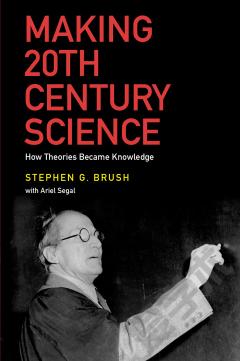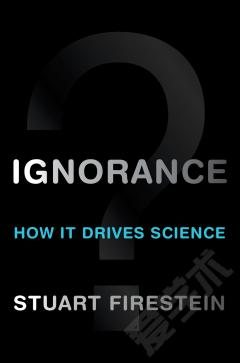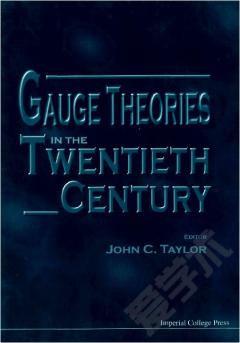Making 20th Century Science —— How Theories Became Knowledge
----- 第20世纪科学:理论如何成为知识
Table of Contents Illustrations Preface PART I THE RECEPTION AND EVALUATION OF THEORIES IN THE SCIENCES Chapter I.1 Who Needs "The Scientific Method"? I.1.1 The Rings of Uranus I.1.2 Maxwell and Popper I.1.3 What is a "Prediction"? A Mercurial Definition I.1.4 Hierarchy and Demarcation I.1.5 What's Wrong with Quantum Mechanics? I.1.6 Was Chemistry (1865-1980) more scientific than Physics? Mendeleev's Periodic Law I.1.7 Scientific Chemists: Benzene and Molecular Orbitals I.1.8 The Unscientific (but very successful) method of Dirac and Einstein: Can We Trust Experiments to Test Theories? I.1.9 Why was Bibhas De's paper rejected by Icarus? I.1.10 The Plurality of Scientific Methods Persons mentioned in this Chapter Chapter I.2 Reception Studies by Historians of Science I.2.1 What is "Reception"? I.2.2 The Copernican Heliocentric System I.2.3 Newton's Universal Gravity I.2.4 Darwin's Theory of Evolution by Natural Selection I.2.5 Bohr Model of the Atom I.2.6 Conclusions and Generalizations Persons mentioned in this Chapter Chapter I.3 The Role of Prediction-Testing in the Evaluation of Theories: A Controversy in the Philosophy of Science I.3.1 Introduction I.3.2 Novelty in the Philosophy of Science I.3.3 What is a Prediction? (Revisited) I.3.4 Does Novelty Make a Difference? I.3.5 Evidence from case histories I.3.6 Are Theorists less trustworthy than Observers? I.3.7 The Fallacy of Falsifiability: Even the Supreme Court was Fooled I.3.8 Conclusions Persons mentioned in this chapter Chapter I.4 The Rise and Fall of Social Constructionism 1975-2000 I.4.1 The Problem of defining "Science and Technology Studies" I.4.2 The Rise of Social Constructionism I.4.3 The Fall of Social Constructionism I.4.4 Post Mortem I.4.5 Consequences for "Science Studies" Persons mentioned in this Chapter PART II ATOMS, MOLECULES, AND PARTICLES Chapter II.1. Mendeleev's Periodic Law II.1.1 Mendeleev and the Periodic Law II.1.2 Novel Predictions II.1.3 Mendeleev's Predictions II.1.4 Reception by Whom? II.1.5 Tests of Mendeleev's Predictions II.1.6 Before the Discovery of Gallium II.1.7 The Impact of Gallium and Scandium II.1.8 The Limited Value of Novel Predictions II.1.9 Implications of the Law II.1.10 Conclusions Persons mentioned in this chapter Chapter II.2 The Benzene Problem 1865-1930 II.2.1 Kekule's Theory II.2.2 The first Tests of Kekule's Theory II.2.3 Alternative Hypotheses II.2.4 Reception of Benzene Theories 1866-1880 II.2.5 New Experiments, New Theories 1881-1900 II.2.6 The Failure of Aromatic Empiricism 1901-1930 Persons mentioned in this Chapter Chapter II.3 The Light Quantum Hypothesis II.3.1 Black-Body Radiation II.3.2 Planck's Theory II.3.3 Formulation of the Light-Quantum Hypothesis II.3.4 The Wave Theory of Light II.3.5 Einstein's "Heuristic Viewpoint" II.3.6 What did Millikan Prove? II.3.7 The Compton Effect II.3.8 Reception of Neo-Newtonian Optics before 1923 II.3.9 The Impact of Compton's Discovery II.3.10 Rupp's Fraudulent Experiments II.3.11 Conclusions Persons Mentioned in this Chapter Chapter II.4 Quantum Mechanics II.4.1 The Bohr Model II.4.2 The Wave Nature of Matter II.4.3 Schrodinger's Wave Mechanics II.4.4 The Exclusion Principle, Spin, and the Electronic Structure of Atoms II.4.5 Bose-Einstein Statistics II.4.6 Fermi-Dirac Statistics II.4.7 Initial Reception of Quantum Mechanics II.4.8 The Community is Converted II.4.9 Novel Predictions of Quantum Mechanics II.4.10 The Helium Atom II.4.11 Reasons for accepting Quantum Mechanics after 1928 Persons mentioned in this Chapter II. 5 New Particles II.5.1 Dirac's Prediction and Anderson's Discovery of the Positron II.5.2 The Reception of Dirac's Theory II.5.3 The Transformation of Dirac's Theory II.5.4 Yukawa's Theory of Nuclear Forces II.5.5 Discovery of the Muon and Reception of Yukawa's Theory II.5.6 The Transformation of the Yukon II.5.7 Conclusions Persons Mentioned in this Chapter Chapter II.6 Benzene and Molecular Orbitals 1931-1980 II.6.1 Resonance, Mesomerism, and the Mule 1931-1945 II.6.2 Reception of Quantum Theories of Benzene 1932-1940 II.6.3 Chemical Proof of Kekule's Theory II.6.4 Anti-Resonance and the Rhinoceros II.6.5 The Shift to Molecular Orbitals after 1950 II.6.6 Aromaticity II.6.7 The Revival of Predictive Chemistry II.6.8 Reception of Molecular Orbital Theory by Organic Chemists II.6.9 Adoption of MO in Textbooks II.6.10 A 1996 Survey II.6.11 Conclusions Persons Mentioned in this Chapter PART III SPACE AND TIME Chapter III.1. Relativity III.1.1 The Special Theory of Relativity III.1.2 General Theory of Relativity III.1.3 Empirical Predictions and Explanations III.1.4 Social-Psychological Factors III.1.5 Aesthetic-Mathematical Factors III.1.6 Early Reception of Relativity III.1.7 Do Scientists Give Extra Credit for Novelty? The Case of Gravitational Light Bending III.1.8 Are Theorists less Trustworthy than Observers? III.1.9 Mathematical/Aesthertic Reasons for Accepting Relativity III.1.10 Social-Psychological Reasons for Accepting Relativity III.1.11 A Statistical Summary of Comparative Reception III.1.12 Conclusions Persons Mentioned in this Chapter Chapter III.2. Big Bang Cosmology III.2.1 The Expanding Universe is Proposed III.2.2 The Age of the Earth III.2.3 The Context for the Debate: Four "New Sciences" and One Shared Memory III.2.4 Cosmology Constrained by Terrestrial Time III.2.5 Hubble Doubts the Expanding Universe III.2.6 A Radical Solution: Steady-State Cosmology III.2.7 Astronomy Blinks: Slowing the Expansion III.2.8 Lemaitre's Primeval Atom and Gamow's Big Bang III.2.9 Arguments for Steady State Weaken III.2.10 The Temperature of Space III.2.11 Discovery of the Cosmic Microwave Background III.2.12 Impact of the Discovery on Cosmologists III.2.13 Credit for the Prediction III.2.14 Conclusions Persons mentioned in this Chapter PART IV HEREDITY AND EVOLUTION Chapter IV.1 Morgan's Chromosome Theory IV.1.1 Introduction IV.1.2 Is Biology like (Hypothetico-Deductive) Physics? IV.1.3 Precursors IV.1.4 Morgan's Theory IV.1.5 The Problem of Universality IV.1.6 Morgan's Theory in Research Journals IV.1.7 Important Early Supporters IV.1.8 Bateson and the Morgan Theory in Britain IV.1.9 The Problem of Universality Revisited IV.1.10 Books and Review Articles on Genetics, Evolution and Cytology IV.1.11 Biology Textbooks IV.1.12 Age Distribution of Supporters and Opponents IV.1.13 Conclusions Persons mentioned in this Chapter Chapter IV.2 The Revival of Natural Selection 1930-1970 IV.2.1 Introduction IV.2.2 Fisher: A new Language for Evolutionary Research IV.2.3 Wright: Random Genetic Drift, A Concept Out of Control IV.2.4 Haldane: A Mathematical-Philosophical Biologist Weighs in IV.2.5 Early Reception of the Theory IV.2.6 Dobzhansky: The Faraday of Biology? IV.2.7 Evidence for Natural Selection, before 1941 IV.2.8 Huxley: A New Synthesis is Proclaimed IV.2.9 Mayr: Systematics and the Founder Principle IV.2.10 Simpson: No Straight and Narrow Path for Paleontology IV.2.11 Stebbins: Plants are also Selected IV.2.12 Chromosome Inversions in Drosophila IV.2.13 Ford: Unlucky Blood Groups IV.2.14 Resistance to Antibiotics IV.2.15 Two "Great Debates": Snails and Tiger Moths IV.2.16 Selection and/or Drift? The Changing Views of Dobzhansky and Wright IV.2.17 The Views of other Founders and Leaders IV.2.18 The Peppered Moth IV.2.19 The Triumph of Natural Selection? IV.2.20 Results of a Survey of Biological Publications IV.2.21 Is Evolutionary Theory Scientific? IV.2.22 Context and Conclusions Persons mentioned in this Chapter PART V CONCLUSIONS Chapter V.1 Which Works Faster: Prediction or Explanation? V.1.1 Comparison of Cases Presented in this Book V.1.2 From Princip to Principe V.1.3 Can Explanation be Better than Prediction? V.1.4 Special Theory of Relativity: Explaining "Nothing" V.1.5 The Old Quantum theory: Many Things are Predicted, but Few are Explained V.1.6 Quantum Mechanics: Many Things are Explained, Predictions are Confirmed too late V.1.7 Millikan's Walk Notes for Part I Notes for Part II Notes for Part III Notes for Part IV Notes for Part V Selected Bibliography: Includes works cited more than once in a chapter Index
{{comment.content}}








 京公网安备 11010802027623号
京公网安备 11010802027623号